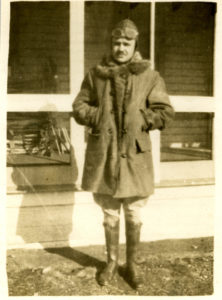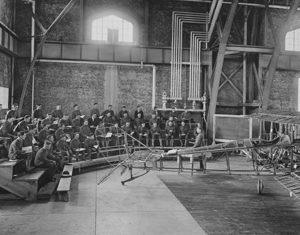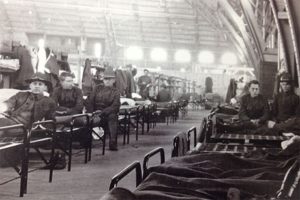 H. G. Britton (Photo shared by W. G. Britton)
H. G. Britton (Photo shared by W. G. Britton)
100 years ago today a letter from Harold Gale (H. G.) Britton to his Uncle David Gibson was published in the Kinsley Graphic. He was 21 years old when he wrote it from the aviation ground school at Cornell University in Ithaca, N.Y.
“This is a military school connected with Cornell University. There are about 500 students studying how to be officers in the aviation section. The school draws from as far west as Chicago. You get wireless, engine work, aeroplane work, drill, machine guns, army regulations. In fact everything an officer should know. Wireless and machine guns I have found the hardest so far as I have gone, but they can be learned all right. The system used is mostly lectures and short recitations. They certainly cram it to you, and the secret of it all is to have a wonderful memory and to pay attention.
We are quartered in a big armory and most of the class rooms are in different towers, which are on all four corners of the building. The armory here is the largest in the state which makes it some building.”
Hundreds of future pilots had quarters in this newly built New York State Armory and Drill Hall. I found the following pictures of a class of cadets and the barracks in the armory accompanying an article, “Cornell Rewind: A great school faces the Great War” by Elaine Engst and Blaine Friedlander, published in the Cornell Chronicle, January 22, 2015 issue. The barracks picture was taken in 1918, the same time H. G. was there.


According to the Chronical article, “For the pilots, final exams required comprehensive and skillful answers. In the engines class, students saw questions like ‘What are the advantages of [a] double ignition system for airplane motors?’ or ‘How many times per second does the interrupter break the primary current of a magneto which is furnishing the ignition for an eight cylinder engine running 1400 rpm?’ or ‘Make a sketch of a two-gear oil pump, showing path of oil and direction of rotation of gears.’”
In this same letter H.G. describes the Thomas Morse Aeroplane Factory and Engine Works that was also in Ithaca: “They are employing lots of men, and wages are very high for this class of work in the east. They are testing planes out every day, using Cayuga Lake as a flying field. The lake is frozen over completely now, some 40 miles long and various widths, so is some lake. A fellow was up yesterday, using an air cooled motor, some 19,000 feet, getting lost and landing 50 miles from here at Syracuse, coming back on a direct line made the 50 miles in 30 minutes flat. That is moving right along.”
The only other reference I could find to H. G.’s military service is his name appears as a Private in the Signal Corps Aviation School in Chandlefield, Pennsylvania (Congressional Record, October 3, 1918). His father, notified the Graphic that he arrived safely overseas (October 3, 1918 Graphic). Four months later, with the war over, the January 9, 1919 Graphic reported “Sergeant Britton who had been instructing in aviation In England for some months” had recently been discharged and was back visiting in Lewis.
H. G. settled in Kinsley, starting the Britton Motor Company and marrying Florene Colver in May, 1926.
